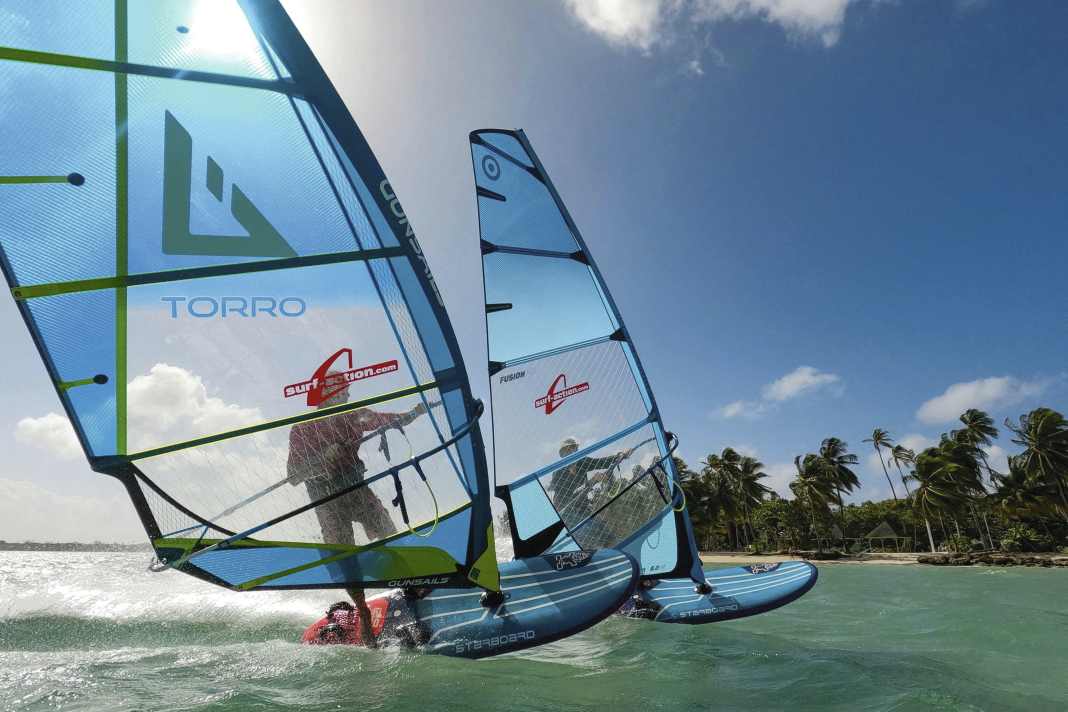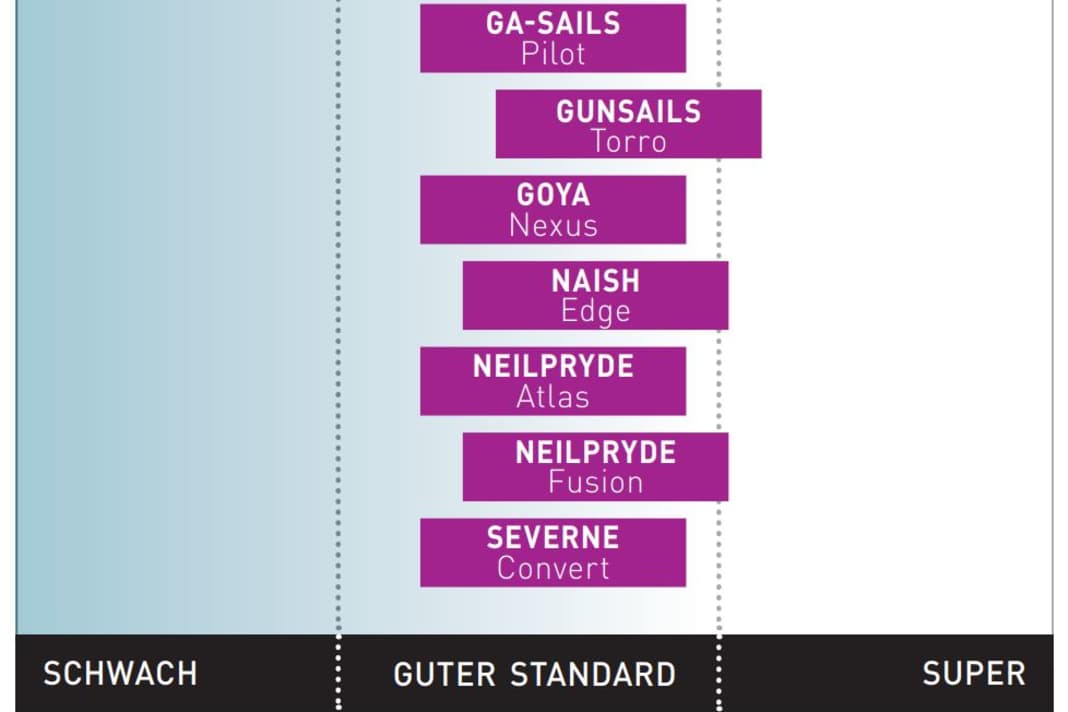Freemoving sails 2025: Nine sails for manoeuvring, freeriding and upwind in the test
Surf Testteam
· 26.03.2025






These sails are included in the test:
Freemovesails and Bielefeld have one thing in common: they don't actually exist. Except in surf magazine. Under the (artificial) term freemove we summarise all sails that are not otherwise subject to a standardised generic term, but which in our opinion cover a standardised range of use. These are usually camberless sails with five battens that cannot be categorised as wave sails. Sails with better handling than freeride sails and more performance than pure wave sails. Sails that are mainly sold in the sizes 5.0 to 6.5 square metres.
Manufacturers, on the other hand, sort these models optionally under "Jump'n Ride", "Freeride-Freewave", "Freeride-5-Batten" "Allround Freeride" and other categories. Freemove is the nimbler little sister of Freeride only in surf magazine and combines all sails that are less powerful, but more agile, livelier, smoother in manoeuvres and, above all, ideally suited to smaller boards with a volume of less than 120 litres. With one exception: these sails are also perfect for advanced beginners, that are just starting with planing - and then also on large-volume boards over 150 litres. For small freeride and freemove boards (Click here for the 95-litre boards test), freemove sails are often much better suited than wave sails, unless the boards are regularly used for wave surfing.
Freemove sails are suitable for planing intermediates and manoeuvring professionals."
Wave sail, economy model or premium
Unfortunately, the original plan to test a good selection of affordable branded sails against the premium products of the same brand only partially materialised. Because the Severne Gator - a freemove classic - was unfortunately not yet available for testing, the affordable Severne Convert can only compete with the other test candidates and the in-house duel is postponed. At GA-Sails, the sail pair consisting of the Hybrid and the cheaper Pilot were at the start together, but the price difference proved to be less than hoped for during the subsequent research. Nevertheless, the comparison remains exciting, because the Pilot has to make do with only four battens in the 6.2 square metre size, which would already be at the limit even for a pure wave sail. For additional stabilisation, it can be assumed that GA-Sails only recommends SDM masts for the Pilot. These are often - but not always - stiffer than RDM masts, and the Pilot could benefit from this. On the other hand, RDM masts give every sail a more manageable appearance and are now standard for sails under six square metres.
This means that the budget segment has largely been covered, as all other brands only have one freemove sail in their programme. But there is one piece of good news at the end: the cheapest sail in the test by far is not a slimmed-down economy model, but the fully equipped Torro from mail order company GunSails. The most expensive sail in the test is the NeilPryde Atlas. When it's not surfing with us in the freemove test, it's usually used to compete in World Cups or to make the toughest wave spots unsafe: a specialist sail, designed for the most demanding wave windsurfers in terms of shape and features. However, it also shows that the most expensive product is not always the best choice - at least not for those who want to grow. Because what the pro appreciates as agile and responsive will probably be perceived as demanding and nervous by the intermediate rider. Many wave sails for experienced surfers are therefore probably also ideal for "bump & jump" on days without waves. However, intermediate riders are better off with a stable freemove sail at a more favourable price.
All details and features of the test sails in picture and video
All sails with trimming tips and features in the video:
The grades of the Freemove sails
In this group, the scores are close together and are predominantly in the "good standard" to "super" range. Nevertheless, the sails differ considerably in their suitability for freeride, freemove or for intermediates, which is due more to their characteristics than to the "measurable" criteria.






Into the waves with a freemove sail?
We did not assess the criterion of wave suitability for the test size of six square metres: because this size is rarely surfed in the waves and because the test spot on Tobago does not offer any wave conditions. However, three sails (including the NeilPryde Atlas wave sail) were already in our luggage and on the water when we tested the Freemoveboards 95: the pure wave sail would definitely have won the wave riding discipline in the entire group by a wide margin. We also consider the Naish Edge and Duotone Duke to be quite suitable - at least for moderate surf - and with their flat profile, high-cut lower leech and manageable boom lengths, they are also quite agile.
Categorisation: Freeride, Bump&Jump, intermediate
For each sail, in addition to the grades, we rate the suitability for freeride, bump & jump and the suitability for gliding climbers with zero to ten "surf waves".
- The term "Freeride" mainly describes the combination of planing and jibing. Those who also attach great importance to very good top speed will also find freeride sails in the six square metre range with six or seven battens, which can withstand even more sail pressure and thus enable better top speed. But even in this group there are some sails that invite you to take long runs. For a good rating, a sail must not lag behind in the speed comparison, it should be stable in the hands and easy to put down to the board deck. The favourites include in particular GunSails Torro, Goya Nexus, Naish Edge, NeilPryde Fusion and Severne Convert.
- Bump&Jump is synonymous with what most surfers who don't do extreme freestyle or surf waves do in medium and strong winds: jumping, learning or refining jibes and trying out one or two new planing manoeuvres. We also include the spin loop in choppy water. All the sails tested are well suited to this, with mostly marginal differences. Sails that are particularly agile or have less batten rotation around the mast get the extra point. Very versatile manoeuvring all-rounders are Duotone Duke, GA-Sails Hybrid, Naish Edge, NeilPryde Fusion.
- For advancing beginners again, it is important that a sail is easy to trim and is stable and forgiving in the hand when planing. When learning the basics of planing, you're busy enough with the board, so the sail shouldn't also take up important resources. Here only the wave sail NeilPryde Atlas gets a very limited recommendation. Although it is super light and easy to handle, it is noticeably more sensitive when planing and therefore more demanding than all "real" freemove sails.
The best sails for learning and perfecting jibes."
How surf tests - equal wind for all
We test planing characteristics, speed potential and controllability during comparison rides on identical boards. Pumping is prohibited when planing, so to assess controllability we always compare sails that were on the water at the same time. "Same wind for all" is the prerequisite for a proper assessment. Jibe handling and riding stability, as well as general riding feel, on the other hand, can be wonderfully determined in manoeuvre rounds in which each tester surfs several sails one after the other.
Test freemove sails: All sails in the individual review
click to go to the individual sail tests!

